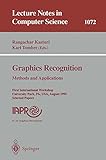Graphics Recognition Methods and Applications [electronic resource] : First International Workshop University Park, PA, USA, August 10–11, 1995 Selected Papers / edited by Rangachar Kasturi, Karl Tombre.
Material type: TextSeries: Lecture Notes in Computer Science ; 1072Publisher: Berlin, Heidelberg : Springer Berlin Heidelberg, 1996Description: X, 314 p. online resourceContent type: text Media type: computer Carrier type: online resourceISBN: 9783540683872Subject(s): Computer science | Artificial intelligence | Computer vision | Optical pattern recognition | Computer aided design | Geographical information systems | Computer Science | Pattern Recognition | Image Processing and Computer Vision | Artificial Intelligence (incl. Robotics) | Geographical Information Systems/Cartography | Systems and Information Theory in Engineering | Computer-Aided Engineering (CAD, CAE) and DesignAdditional physical formats: Printed edition:: No titleDDC classification: 006.4 LOC classification: Q337.5TK7882.P3Online resources: Click here to access online
TextSeries: Lecture Notes in Computer Science ; 1072Publisher: Berlin, Heidelberg : Springer Berlin Heidelberg, 1996Description: X, 314 p. online resourceContent type: text Media type: computer Carrier type: online resourceISBN: 9783540683872Subject(s): Computer science | Artificial intelligence | Computer vision | Optical pattern recognition | Computer aided design | Geographical information systems | Computer Science | Pattern Recognition | Image Processing and Computer Vision | Artificial Intelligence (incl. Robotics) | Geographical Information Systems/Cartography | Systems and Information Theory in Engineering | Computer-Aided Engineering (CAD, CAE) and DesignAdditional physical formats: Printed edition:: No titleDDC classification: 006.4 LOC classification: Q337.5TK7882.P3Online resources: Click here to access online  E-BOOKS
E-BOOKS
| Current library | Home library | Call number | Materials specified | URL | Status | Date due | Barcode |
|---|---|---|---|---|---|---|---|
| IMSc Library | IMSc Library | Link to resource | Available | EBK6977 |
Basic techniques and symbol-level recognition — An overview -- An alternative approach to the performance evaluation of thinning algorithms for document processing applications -- Comparison of methods for detecting corner points from digital curves -- Detection of horizontal lines in noisy run length encoded images: The FAST method -- Adding geometric constraints to the vectorization of line drawings -- Quantitative measurement of the performance of raster-to-vector conversion algorithms -- Form item extraction based on line searching -- Model-based analysis of printed tables -- Morphological approach for dashed lines detection -- General diagram-recognition methodologies -- Automatic learning and recognition of graphical symbols in engineering drawings -- A hybrid system for locating and recognizing low level graphic items -- Automatic interpretation of chemical structure diagrams -- Knowledge-based segmentation for automatic map interpretation -- Automatic region labeling of the layered map -- Verification-based approach for automated text and feature extraction from raster-scanned maps -- Software system design for paper map conversion -- Object-process based segmentation and recognition of ANSI and ISO standard dimensioning texts -- A combined high and low level approach to interpreting scanned engineering drawings -- Functional parts detection in engineering drawings: Looking for the screws -- Reconstruction of 3D solid model from three orthographic views — Top-down approach -- A benchmark: Performance evaluation of dashed-line detection algorithms -- How to win a dashed line detection contest -- Summary and recommendations.
This book contains revised refereed papers selected from the presentations at the First International Workshop on Graphics Recognition, held in University Park, PA, USA, in August 1995. The 23 full papers included are divided into sections on low-level processing, vectorization and segmentation of scanned graphics documents; symbol and diagram recognition, map processing, interpretation of engineering drawings. Each section contains both survey articles to assess the state of the art, and research papers presenting novel results. One section is devoted to a contest held to determine the best algorithm for detection of dashed lines in drawings. The final chapter summarizes the conclusions and recommendations of the discussions held during the workshop.


There are no comments on this title.